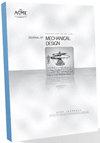Discrete structural design synthesis: a hierarchical-inspired deep reinforcement learning approach considering topological and parametric actions
IF 2.9
3区 工程技术
Q2 ENGINEERING, MECHANICAL
引用次数: 0
Abstract
Structural design synthesis considering discrete elements can be formulated as a sequential decision process solved using deep reinforcement learning (DRL), shown in prior work to naturally accommodate discrete actions and efficiently provide adept solutions to a variety of problems. By modeling structural design synthesis as a Markov decision process (MDP), the states correspond to specific structural designs, the actions correspond to specific design alterations, and the rewards are related to the improvement in the altered design's performance with respect to the design objective and specified constraints. Here, the MDP action definition is extended by integrating parametric design grammars that further enable the design agent to not only alter a given structural design's topology, but also its element parameters. In considering topological and parametric actions, both the dimensionality of the state and action space and the diversity of the action types available to the agent in each state significantly increase, making the overall MDP learning task more challenging. Hence, this paper also addresses discrete design synthesis problems with large state and action spaces by significantly extending the framework. A hierarchical-inspired deep neural network architecture is developed to equip the agent to learn the type of action, topological or parametric, to apply, thus reducing the complexity of possible action choices in a given state. This extended framework is applied to the design synthesis of planar structures considering both discrete elements and cross-sectional areas, and it is observed to adeptly learn policies that synthesize high performing design solutions.离散结构设计合成:考虑拓扑和参数作用的分层启发式深度强化学习方法
考虑到离散元素的结构设计合成可以表述为使用深度强化学习(DRL)求解的顺序决策过程,先前的工作表明,DRL 能够自然地适应离散行动,并高效地为各种问题提供专业的解决方案。通过将结构设计合成建模为马尔可夫决策过程(MDP),状态对应于特定的结构设计,行动对应于特定的设计变更,而奖励则与设计目标和特定约束条件下设计变更后的性能改进相关。在这里,通过整合参数化设计语法对 MDP 动作定义进行了扩展,使设计代理不仅能改变给定结构设计的拓扑结构,还能改变其元素参数。在考虑拓扑和参数行动时,状态和行动空间的维度以及代理在每个状态下可用的行动类型的多样性都会显著增加,从而使整个 MDP 学习任务更具挑战性。因此,本文还通过大幅扩展框架来解决具有大型状态和行动空间的离散设计合成问题。本文开发了一种受分层启发的深度神经网络架构,让代理学习要应用的行动类型(拓扑或参数),从而降低了给定状态下可能的行动选择的复杂性。我们将这一扩展框架应用于同时考虑离散元素和横截面积的平面结构的设计合成,并观察到它能够熟练地学习合成高性能设计方案的策略。
本文章由计算机程序翻译,如有差异,请以英文原文为准。
求助全文
约1分钟内获得全文
求助全文
来源期刊

Journal of Mechanical Design
工程技术-工程:机械
CiteScore
8.00
自引率
18.20%
发文量
139
审稿时长
3.9 months
期刊介绍:
The Journal of Mechanical Design (JMD) serves the broad design community as the venue for scholarly, archival research in all aspects of the design activity with emphasis on design synthesis. JMD has traditionally served the ASME Design Engineering Division and its technical committees, but it welcomes contributions from all areas of design with emphasis on synthesis. JMD communicates original contributions, primarily in the form of research articles of considerable depth, but also technical briefs, design innovation papers, book reviews, and editorials.
Scope: The Journal of Mechanical Design (JMD) serves the broad design community as the venue for scholarly, archival research in all aspects of the design activity with emphasis on design synthesis. JMD has traditionally served the ASME Design Engineering Division and its technical committees, but it welcomes contributions from all areas of design with emphasis on synthesis. JMD communicates original contributions, primarily in the form of research articles of considerable depth, but also technical briefs, design innovation papers, book reviews, and editorials.
 求助内容:
求助内容: 应助结果提醒方式:
应助结果提醒方式:


